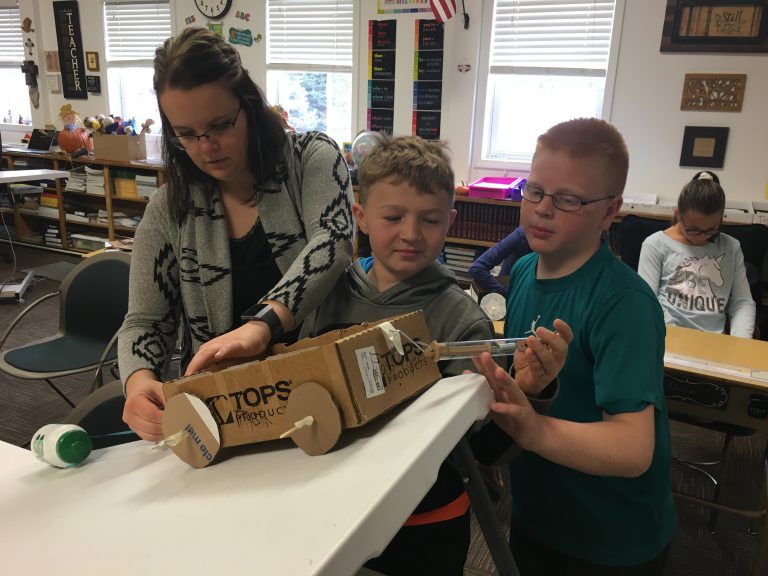While local 4-H groups are known for summer programming, educator Julie Kreikemeier works with hundreds of students year-round across Colfax and Cuming counties in eastern Nebraska, designing lessons and projects that draw on what students are learning in school.
And when floods ravaged homes in both areas this spring, she tried to make 4-H a space of stability for students and their families.
“It’s … very much just trying to maintain a sense of normalcy. What do they remember as a normal fair experience? What did they remember as a normal end of school year experience?”
And when their “new normal” became too glaring to ignore, creating a web of support was a group effort. Some days, parents volunteered to take home kids whose homes were flooded for playdates.
“Just so they could get away from it all for an afternoon,” Kreikemeier said.
As for her older students, they helped replace landscaping for families left with sand-crusted front yards. She thinks using club time for community service gave them a sense of purpose amid the turbulence.
But as the community continues to recover, Kreikemeier has been wondering how to ask a simple, but loaded question: how are you doing, really?
“Somebody can tell you what it was like to watch the water rise, and to watch livestock move and to watch … the river come out of the banks, but they’re not going to tell you how it made them feel,” she said.
It’s hard to look past the challenges families in agriculture have faced this year. Between floods, late planting, and trade turmoil, many families are operating under an extra layer of stress. But addressing the culture of mental health in rural schools and communities is proving more complicated than increasing resources.
Kreikemeier has noticed many students don’t understand what phrases like mental health or depression mean, and aren’t comfortable using them. Having grown up in Dodge, Nebraska, a town of 531, that attitude hasn’t surprised her.
“You can come out right out loud and say, ‘Today, we’re talking about suicide prevention’, and what’s going to happen? Most people are going to shut down. They’re not going to listen,” she said.
Jackie Meyer, a counselor who practices across northeastern Nebraska, thinks the stigma ag communities live with is partly tied to their work. She hears the same lines all the time.
“This is the way farming is, this is what happens, and next year will be better, everybody else has always taken care of it all these years, so I should be able to do that,” she recited. “But sometimes it doesn’t get better, and you lose your farm.”
Regional behavioral health agencies this year have increased their outreach to agricultural areas where families are struggling to recover from the flooding. And organizations like the Rural Response Hotline in Nebraska are finding some success connecting families to free counseling during financial advisor appointments.
But Meyer said on the whole, most are still not biting.
Philisha Stallbaumer gets it.
“People have a difficult time asking for that stuff,” she said.
Stallbaumer manages Schools That Care, a school-based program that connects students, staff, and families with mental health resources in two rural Kansas school districts. She and her husband both come from ag backgrounds.
“I probably wouldn’t have asked either, if we had needed it, at the time,” Staullbaumer said.
But after five parents in one graduating class died by suicide, it was obvious students needed more support. The program received a grant in 2015 through the U.S. Department of Human Services to hire in-school social workers, and tasked them with teaching staff about mental health.
“The first year we kind of sat back and let everybody get used to the idea that we had a school social worker, and went through training and provided them information,” she said.
A year later, the number of students, staff, and parents who used the school social worker had more than doubled. Administrators had also warmed to the program.
Stallbaumer thinks the program works partly because students seem more comfortable with social workers if their roles are blended into the larger school community. That way, social workers aren’t thought of as someone students talk with only when something is wrong.
The setup resembles the integrative care model, where a mental health provider and a primary care provider see patients in the same office. Meyer, the Nebraska counselor, thinks combining practices would be a good way to show communities mental health is part of overall well being.
“The mental health stuff is normal, just like a headache, or the flu. It’s normal. We will get these,” she said.
Plus, a combined office could attract people who don’t want to be seen entering a mental health facility. She likes telehealth for the same reason.
“If I’m sitting at home, looking at my computer like everybody else, nobody’s going to know that I’m seeing a therapist,” she said. Telehealth also allows her to connect with families in areas where mental health resources are limited.
But does letting mental health care stay secretive contribute to stigma?
“It could,” she said. But the problem is too urgent to search for a perfect solution. “We need the help now.”
Meyer said she’s hopeful, as always, that the culture around mental health can slowly improve in rural areas.
“Because there’s so much we can do to get people help. They don’t have to suffer, they don’t have to live their lives in depression,” she said.
Part of why she loves living in a rural community is the tight-knit relationships. She doesn’t see why they can’t include franker conversations about mental health.
“If I know if I have a friend that I can go to when I feel really depressed, that friend’s going to help me. He doesn’t know squat about mental health or counseling, but just being there.”
Meyer trailed off before finding the words.
“They feel felt,” she said. “That’s mental health. Feeling felt.”
Follow Christina on Twitter: @c_c_stella

